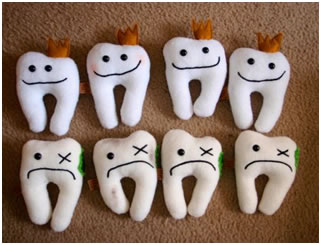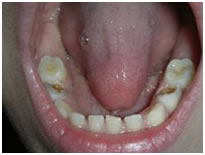Dental Caries in Preschool Children

Photo: Mandy Jouan
Dental caries is an infectious and communicable disease and that multiple factors influence the initiation and progression of the disease. Dental caries in preschool children is due to a combination of factors, including colonization of teeth with cariogenic bacteria, type of foods and frequency of exposure of these foods to the cariogenic bacteria, and susceptible teeth.
Microbiologic factors: Mutans streptococci (MS) are the group of microorganisms most associated with the dental caries process and the key to the understanding of caries in preschool children. Colonization of the oral cavity with MS in children is generally the result of transmission of these organisms from the child’s mother. The transmission is suspected to be due to close maternal-child contact and sharing of food and utensils. The colonization with MS at an early age is an important factor for early caries initiation. While there are many studies have shown on when a child is first colonized by MS, there is a well-known study reported a “window of infectivity” in which the acquisition of MS occurs between 19 and 31 months of age. But there are recent reports that show that predentate children can be colonized with MS. Maternal factors, such as high levels of MS, poor oral hygiene, low socioeconomic status, and frequent snacking, contribute to this maternal transfer.
Dietary factors: Caries risk is greatest if sugars are consumed at high frequency and are in a form that is retained in the mouth for long periods. Sucrose commonly known as table sugar is the most cariogenic sugar used in many food products including ice cream, baked goods, desserts, confections, cookies and pastries, and soft drinks. The intensity of caries in preschool children may be due to frequent sugar consumption. High frequency sugar consumption enables copious acid production by cariogenic bacteria that are adherent to teeth.
Tooth factors: Lack of enamel maturation or the presence of developmental defects in enamel may increase the caries risk in preschool children. Such defects enhance plaque retention increase MS colonization and in severe cases the loss of enemal enables greater susceptibility to tooth demineralization. Enamel defects in the primary dentition are most associated with low birth weight, and the child’s or mother’s malnutrition or illness. The prevalence of enamel defects are ranging from 13%-39% in normal full-term infants to over 62% in preterm infants with very low birth weight in the primary dentition.

Severe tooth decay in a preschool child
Sources
Tinanoff, N. and Palmer, C. A. (2000), Dietary Determinants of Dental Caries and Dietary Recommendations for Preschool Children. Journal of Public Health Dentistry, 60: 197–206
Tinanoff, N., Kanellis M.K., Vargas C.M. (2002). Current understanding of the epidemiology, mechanisms, and prevention of dental caries in preschool children. Pediatric Dentistry, 24:543-548
http://www.utmb.edu/pedi_ed/
McDonald RE, Avery DR, StookeyAG, Chin JR, Kowolik JE. Dental caries in the child and adolescent. In: Dean JA, Avery DR, McDonald RE. Dentistry for the child and adolescent. St. Louis, Mosby Elsevier, 9th ed., 2011, p:177-204.





